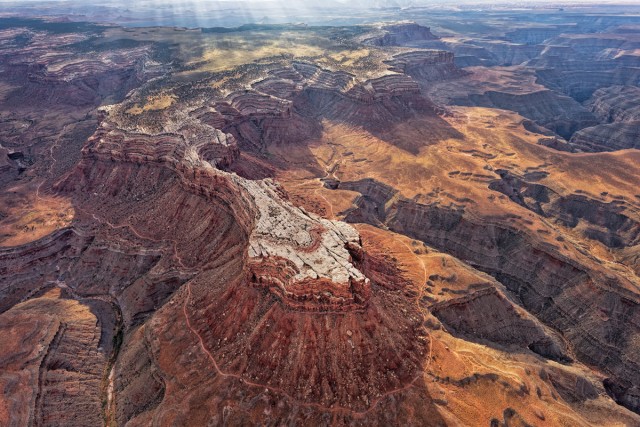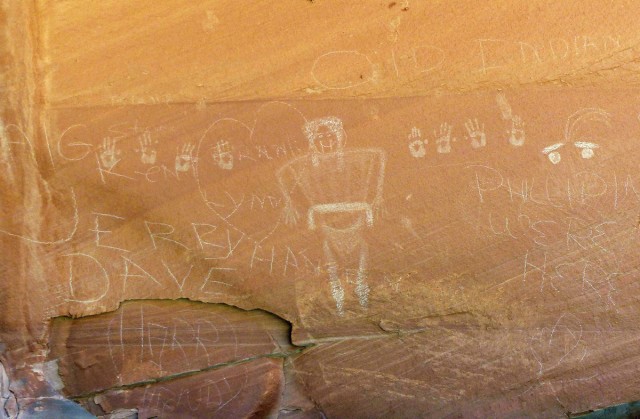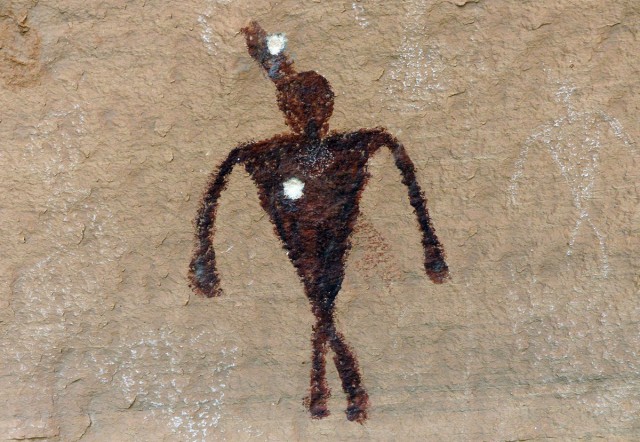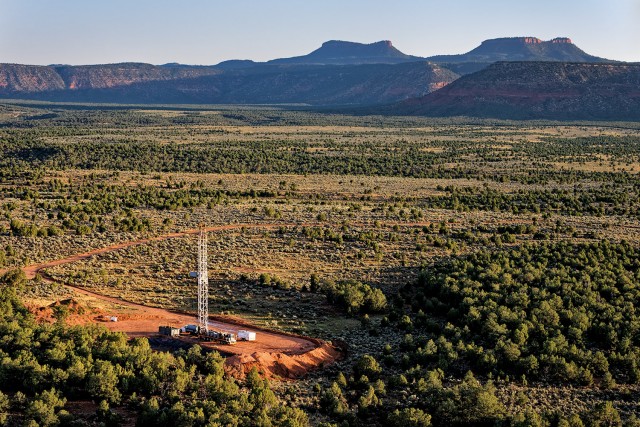- Home
- >
- Preservation Archaeology Blog
- >
- Cedar Mesa and Preservation Archaeology
My number of waking hours in Bluff, Utah, was just slightly more than the 16-hour round-trip drive from Tucson to attend the annual Celebrate Cedar Mesa Weekend. It was well worth the effort. As the program rolled out to some 300 attendees, I was thrilled to see that it was a well-integrated example of Preservation Archaeology in action.
Friends of Cedar Mesa (FOCM) is the nonprofit group that is the prime mover in the effort to bring wider recognition and stronger protection to the Cedar Mesa cultural landscape. They are working tirelessly to promote either a National Conservation Area or a National Monument that would encompass the Greater Cedar Mesa area. The most recent issue of the Archaeology Southwest Magazine was a special double issue on Cedar Mesa, and we specifically intended to help bolster FOCM’s protection efforts.

I was given a 10-minute spot on the stage to talk about the importance of Cedar Mesa in Southwest archaeology—yes, just 10 minutes. That impossible task was greatly assisted by directing the audience to seek a fuller coverage of that topic in the Magazine issue. From a research perspective, Cedar Mesa pretty much has it all—a full 13,000 years of human use of that remarkable landscape. I highlighted two essentials in my precious moments. First, this place has such a powerful archaeological record, that we really want to encourage visitation. Experiencing places of the past where pecked and painted images on the rocks are truly magnificent is an essential goal for a Preservation Archaeologist. Second, protecting this place from those same visitors is essential. Already, average visitation at Cedar Mesa is 70,000 per year for the past 5 years, according to the BLM. A balanced approach to education is the best way to move forward.
The “rock star performances” of the morning session were from a seasoned veteran and a new arrival on the scene. The veteran, aerial photographer Adriel Heisey, explained the Zen unity that he shares with his flying machine, and he helped us imagine how it enables a remarkable freedom to capture those fleeting instances when light, substance, and perspective come together to produce images with a depth and a power that communicates in visceral ways. He then shared a nine-minute multimedia presentation of his Greater Cedar Mesa aerial photography. Absolutely stunning. After the lights came back on as the presentation ended, FOCM President Vaughn Hadenfeldt asked with emotion, “Who doesn’t believe that incredible landscape needs to be preserved?”

The second rock star was notable first for his youth. Blanding (Utah) Boy Scout Porter Bradford exhibited a maturity and intense commitment that caught the crowd off guard—in a happy way. He and his dad discovered a four-acre landscape of tiny arches that turned out to derive from ancient proto-mammals from the era of the dinosaurs. He has documented them in detail and is now working to get them protected. His youthful enthusiasm and determination was an inspiration to all who heard him speak.
The afternoon featured research updates that all fit nicely into a Preservation Archaeology framework. I want to highlight two. Ben Bellorado, a University of Arizona graduate student, is spending time with volunteers and with tree-ring scientist Tom Windes, visiting the standing architecture (some of it just barely standing) of the Cedar Mesa area. Many of the plastered walls—particularly on the kivas of the 1200s—have either impressions or drawings of sandals on their interior wall surfaces. There is a great deal of design variation in these images preserved in clay. Ben and his loyal volunteers record the murals and take tree-ring samples. The result is that some of these rich repositories of ancient design information can be dated quite precisely. As the database builds, Ben hopes to look at changing patterns in social identity and interaction using this unique dataset. The impact to the archaeological record is minimal. And this work serves to document resources—standing (for now at least) architecture that is threatened by increased visitation and by time.

The other Preservation Archaeology highlight was Laurie Webster’s ongoing pursuit of the perishable artifacts— that were mined from the sites of Cedar Mesa and Grand Gulch over a century ago. More than 5,000 perishables ended up in several major museums. Despite their remarkable preservation, they are little studied and poorly documented, let alone understood. Laurie has examined almost half of these known specimens over the past half-decade. She shared a visual cascade of images of items that archaeologists rarely see in archaeological context. Her work clearly dovetails with the sandal and other images that are in the architecture Ben Bellorado is pursuing. The Preservation Archaeologist can only admire the coming together of two such model examples of minimal-impact fieldwork and new research on existing collections. Excellent work, Ben and Laurie!
There was more, but those two presentations were the Preservation Archaeology “strong cases.” A brief summary of the others:
- Anne Phillips is leading volunteers in high-integrity recording of rock art. They pay special attention to documenting current condition.
- Mark Varien shared Crow Canyon’s big-picture research into the emergence of village life in southwestern Colorado.
- Jonathan Till showed how previous information can be reinterpreted as new insights and understanding develops in a region. A new Chacoan road segment and a fuller picture of a rich cultural landscape that links a diversity of Bluff-area archaeological sites was impressive. Tenacious archaeologists like Jonathan are very impressive.
- Jay Willian—another very determined archaeologist—made the near-invisible visible and comprehensible. The very light touch of Navajo and Ute residents in the Bluff area was highlighted through archaeology and interpretations of historical photos and documents.
- Winston Hurst told a remarkable story—or as he labeled it, a “back story”—of how one of the subtle Navajo campsites in the area came to be.
The audience deserves comment as well. There were many professional archaeologists, from government and private-sector contexts. But there was also a diverse group of people who knew Cedar Mesa archaeology on the ground and truly cared deeply about it. Site stewards, folks interested in and involved in rock art recording, people who read, think, and vote. There was strong support for increasing the protections over Cedar Mesa, especially a Greater Cedar Mesa.

There are topics I haven’t covered, but the political tension was always very close at hand. Friends of Cedar Mesa takes a balanced and straightforward approach. Oil and gas development or off-road vehicle use do have appropriate places. But Greater Cedar Mesa is not the place for such activities. There are longer-term, sustainable economic opportunities for the region that respect its rich and still incompletely understood heritage. The concern is that political short-sightedness may be the biggest threat to this region. Last week, the Utah Senate passed a resolution stating that “the highest and best use” of the Cedar Mesa area is grazing and energy/mineral development.
I strongly disagree. I would venture that every attendee at last weekend’s event would also strongly disagree. The event presented abundant evidence for appreciating and preserving the remarkable heritage of Greater Cedar Mesa. The political challenge is engaged and must be sustained by the supporters of Greater Cedar Mesa.
6 thoughts on “Cedar Mesa and Preservation Archaeology”
Comments are closed.
Explore the News
Related to This
-
Project Standing with Bears Ears

Bill: Excellent summary of the day’s events. You skirted mentioning specific comments from the San Juan Country Commissioner’s arguing in favor of jobs from mineral exploitation in the Cedar Mesa Area. She obviously is responding to political (short-term) expediency. Energy jobs are short-term and destroy what can be an economic asset for many years to come. Plus, energy development does not create many local jobs and the ones created are at the lowest wages. Alas, this is another case where we must be vigilant against mis-informed politicians. Thanks for taking the effort to report on this important event. John Pitts
I agree. To achieve any short-term economic gains by exploiting oil and gas on Cedar Mesa would require sacrificing the cultural values, the experiential values, and the archaeological values. Those values all have long-term economic potential for the region, and preservation of those values on Greater Cedar Mesa was the clear consensus of the attendees.
Bill,
Thank you for the summary. So much was packed into Saturday’s agenda that I felt glued to the room. I appreciate your devotion of space in the magazine to Cedar Mesa. I have been visiting Bluff and Cedar Mesa for 10 years and it is so very special. I’m guessing some of the state senators who declared Cedar Mesa’s “highest and best use” to be extractive ones have never been there or only have seen it from a plane or car window.
Keep up the great work!
Mary ‘Mac’ Friends of Cedar Mesa “fan”
It was a great gathering last weekend, though I could only attend Friday night due to work schedule…up here on Cedar Mesa! I drove down from Natural Bridges to Bluff to be there, then up the Moki Dugway to sleep before work the next day.
You all inspire me, like this land does.
Missing the Cedar Mesa Conference because you were actually ON Cedar Mesa seems pretty reasonable to me.